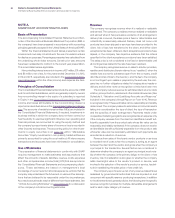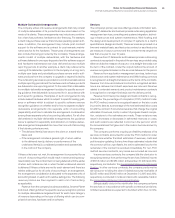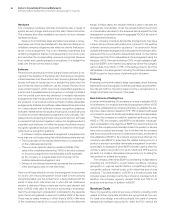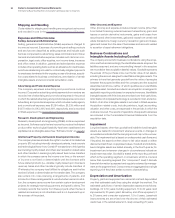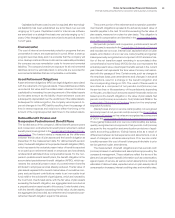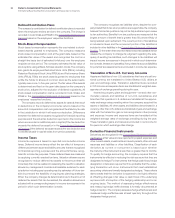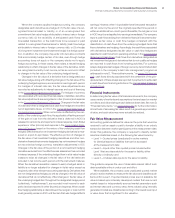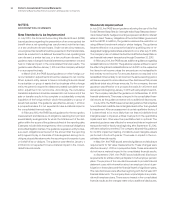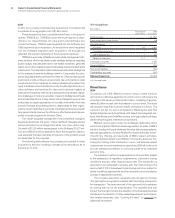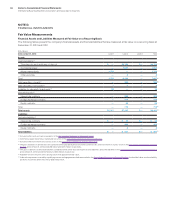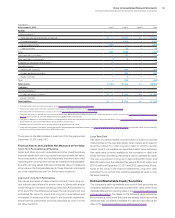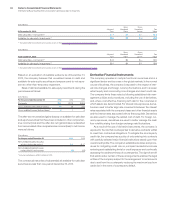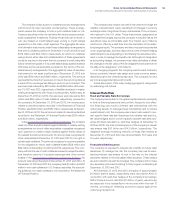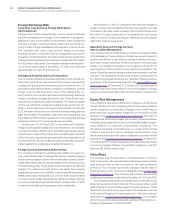IBM 2013 Annual Report Download - page 95
Download and view the complete annual report
Please find page 95 of the 2013 IBM annual report below. You can navigate through the pages in the report by either clicking on the pages listed below, or by using the keyword search tool below to find specific information within the annual report.Notes to Consolidated Financial Statements
International Business Machines Corporation and Subsidiary Companies
94
NOTE B.
ACCOUNTING CHANGES
New Standards to be Implemented
In July 2013, the Financial Accounting Standards Board (FASB)
issued guidance regarding the presentation of an unrecognized tax
benefit when a net operating loss carryforward, a similar tax loss,
or a tax credit carryforward exists. Under certain circumstances,
unrecognized tax benefits should be presented in the financial state-
ments as a reduction to a deferred tax asset for a net operating loss
carryforward, a similar tax loss, or a tax credit carryforward. The
guidance was a change in financial statement presentation only and
has no material impact in the consolidated financial results. The
guidance was effective January 1, 2014, and the company will adopt
it on a prospective basis.
In March 2013, the FASB issued guidance on when foreign cur-
rency translation adjustments should be released to net income.
When a parent entity ceases to have a controlling financial interest
in a subsidiary or group of assets that is a business within a foreign
entity, the parent is required to release any related cumulative trans-
lation adjustment into net income. Accordingly, the cumulative
translation adjustment should be released into net income only if the
sale or transfer results in the complete or substantially complete
liquidation of the foreign entity in which the subsidiary or group of
assets had resided. The guidance was effective January 1, 2014 on
a prospective basis. It is not expected to have a material impact in
the consolidated financial results.
In February 2013, the FASB issued guidance for the recognition,
measurement and disclosure of obligations resulting from joint and
several liability arrangements for which the total amount of the obli-
gation within the scope of the guidance is fixed at the reporting date.
Examples include debt arrangements, other contractual obligations
and settled litigation matters. The guidance requires an entity to mea-
sure such obligations as the sum of the amount that the reporting
entity agreed to pay on the basis of its arrangement among its co-
obligors plus additional amounts the reporting entity expects to pay
on behalf of its co-obligors. The guidance was effective January 1,
2014 and is not expected to have a material impact in the consoli-
dated financial results.
Standards Implemented
In July 2013, the FASB issued guidance allowing the use of the Fed
Funds Effective Swap Rate (or Overnight Index Swap Rate) as a bench-
mark interest rate for hedge accounting purposes in addition to interest
rates on direct Treasury obligations of the United States government
and the LIBOR. In addition, the guidance removes the restriction on
using different benchmark rates for similar hedges. The guidance
became effective on a prospective basis for qualifying new or re-
designated hedging relationships entered into on or after July 17, 2013.
The company has not utilized the Fed Funds Effective Swap Rate on
any financial instrument transactions through December 31, 2013.
In February 2013, the FASB issued additional guidance regarding
reclassifications out of AOCI. The guidance requires entities to report
the effect of significant reclassifications out of AOCI on the respective
line items in net income unless the amounts are not reclassified in
their entirety to net income. For amounts that are not required to be
reclassified in their entirety to net income in the same reporting period,
entities are required to cross-reference other disclosures that provide
additional detail about those amounts. For the company, the new
guidance was effective on a prospective basis for all interim and
annual periods beginning January 1, 2013 with early adoption permit-
ted. The company adopted the guidance in its December 31, 2012
financial statements. There was no impact in the consolidated finan-
cial results as the guidance related only to additional disclosures.
In July 2012, the FASB issued amended guidance that simplifies
how entities test indefinite-lived intangible assets other than goodwill
for impairment. After an assessment of certain qualitative factors, if
it is determined to be more likely than not that an indefinite-lived
intangible asset is impaired, entities must perform the quantitative
impairment test. Otherwise, the quantitative test is optional. The
amended guidance was effective for annual and interim impairment
tests performed for fiscal years beginning after September 15, 2012,
with early adoption permitted. The company adopted this guidance
for its 2012 impairment testing of indefinite-lived intangible assets
performed in the fourth quarter. There was no impact in the con-
solidated financial results.
In May 2011, the FASB issued amended guidance and disclosure
requirements for fair value measurements. These changes were
effective January 1, 2012 on a prospective basis. These amendments
did not have a material impact in the consolidated financial results.
In September 2011, the FASB issued additional disclosure
requirements for entities which participate in multi-employer pension
plans. The purpose of the new disclosures was to provide financial
statement users with information about an employer’s level of par-
ticipation in these plans and the financial health of significant plans.
The new disclosures were effective beginning with the full year 2011
financial statements. The company does not participate in any mate-
rial multi-employer plans. There was no impact in the consolidated
financial results as the changes relate only to additional disclosures.


